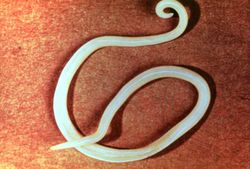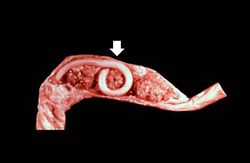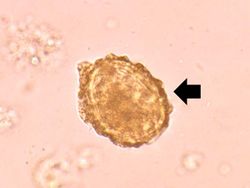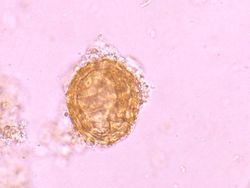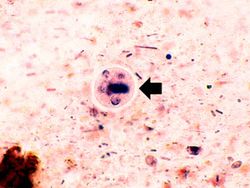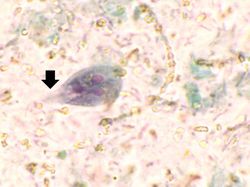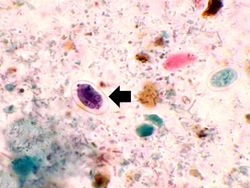Difference between revisions of "IPLab:Lab 11:Ascariasis"
Seung Park (talk | contribs) (→Journal Articles) |
Seung Park (talk | contribs) (→Images) |
||
| (2 intermediate revisions by the same user not shown) | |||
| Line 30: | Line 30: | ||
=== Images === | === Images === | ||
| − | + | * [{{SERVER}}/library/index.php?/tags/2162-ascariasis PEIR Digital Library: Ascariasis] | |
| − | + | * [http://library.med.utah.edu/WebPath/INFEHTML/INFECIDX.html WebPath: Infection] | |
| − | |||
| − | |||
{{IPLab 11}} | {{IPLab 11}} | ||
[[Category: IPLab:Lab 11]] | [[Category: IPLab:Lab 11]] | ||
Latest revision as of 01:46, 30 August 2013
Contents
Clinical Summary[edit]
Shortly after arriving home after two years in Peru with the Peace Corps this 27-year-old female presented to the emergency room with a fever of 103.5°, anterior cervical lymphadenopathy, and pharyngitis. A rapid Strep test was positive and she was treated with penicillin.
Two days later she returned to the emergency room with abdominal distension, paroxysmal periumbilical pain, and repeated emesis. On examination, there was diffuse abdominal tenderness and bowel sounds were hyperactive and high-pitched. The WBC count was unremarkable except for a 12% eosinophilia. An upright film of the abdomen revealed dilated loops of small bowel with air fluid levels and the absence of colonic gas. Surgical exploration confirmed the presumptive diagnosis of small bowel obstruction and identified a tangled mass of approximately 50 adult Ascaris lumbricoides worms as the cause.
One-week post surgery, stool examination revealed the continued presence of Ascaris ova, as well as cysts of Entamoeba histolytica and Giardia lamblia. The patient was treated with appropriate anthelmintics and made a complete recovery.
Images[edit]
Study Questions[edit]
Additional Resources[edit]
Reference[edit]
Journal Articles[edit]
- ten Hove RJ, van Esbroeck M, Vervoort T, van den Ende J, van Lieshout L, Verweij JJ. Molecular diagnostics of intestinal parasites in returning travellers. Eur J Clin Microbiol Infect Dis 2009 Sep;28(9):1045-53.
Images[edit]
| |||||
A normal eosinophil count is less than 5%.
